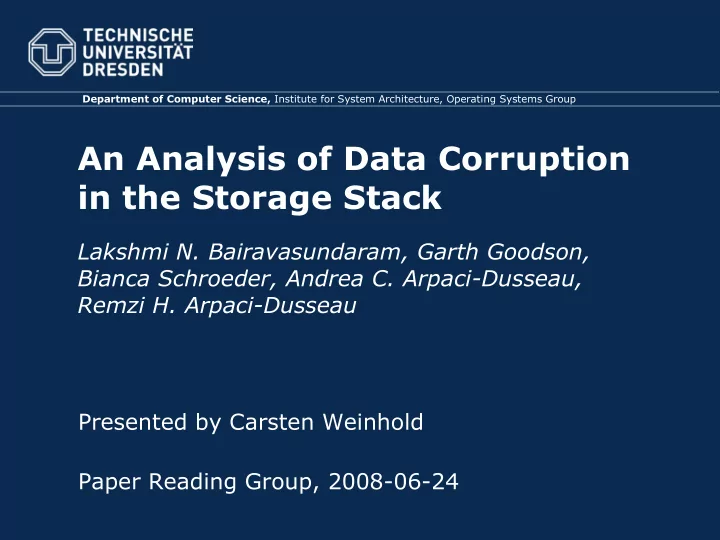

Department of Computer Science, Institute for System Architecture, Operating Systems Group An Analysis of Data Corruption in the Storage Stack Lakshmi N. Bairavasundaram, Garth Goodson, Bianca Schroeder, Andrea C. Arpaci-Dusseau, Remzi H. Arpaci-Dusseau Presented by Carsten Weinhold Paper Reading Group, 2008-06-24
About the Study • Large scale study: – Tens of thousands of production systems – 41 months – 1.53 million disks – 400,000+ checksum mismatches • Both “nearline” and enterprise class disks • Focus on silent data corruption (e.g., not about latent sector errors) Paper Reading Group, 2008-06-24 Slide 2 of 21
Background: NetApp Storage Systems • All storage systems by Network Appliance TM • Dedicated network filers: – WAFL file system – RAID with parity – SCSI layer – Fibre Channel (FC) loops – Fibre Channel disks / SATA disks with adapter • Data collected using “Autosupport” • Sent to central database • Note: not all disks were in use for the full duration of 41 months Paper Reading Group, 2008-06-24 Slide 3 of 21
Background: Data Integrity Segments Paper Reading Group, 2008-06-24 Slide 4 of 21
Corruption & Detection Paper Reading Group, 2008-06-24 Slide 5 of 21
Summary Statistics • Total of 1.53 million disks • Total of 400,000+ checksum mismatches • Percentage of corrupt disks varies: – 0.86% of 358,000 nearline disks – 0.065% of 1,170,000 enterprise class disks Observation 1: the probability of developing checksum mismatches is an order of magnitude higher for nearline disks (+SATA/FC adapter) than for enterprise class disks Paper Reading Group, 2008-06-24 Slide 6 of 21
Factor Disk Age: Nearline Disks Paper Reading Group, 2008-06-24 Slide 7 of 21
Factor Disk Age: Enterprise Class Disks Paper Reading Group, 2008-06-24 Slide 8 of 21
Observations Observation 2: probability of developing checksum mismatches varies significantly across disk models in the same class of disks Observation 3: age affects disk models differently with respect to the probability of developing checksum mismatches Paper Reading Group, 2008-06-24 Slide 9 of 21
Factor Disk Size ?? Paper Reading Group, 2008-06-24 Slide 10 of 21
(Non-)Factors ?? Observation 4: there is no clear indication that disk size affects the probability of developing checksum mismatches Observation 5: there is no clear indication that workload affects the probability of developing checksum mismatches ... but: the collected data on access patterns was very coarse and likely to be insufficient Paper Reading Group, 2008-06-24 Slide 11 of 21
Characteristics: Models, Classes Observation 6: the number of checksum mismatches varies greatly across disks Observation 7: on average, corrupt enterprise class disks develop many more checksum mismatches than corrupt nearline disks Paper Reading Group, 2008-06-24 Slide 12 of 21
Characteristics: Disks and Disk Shelves Observation 8: checksum mismatches within the same disk are not independent Observation 9: the probability of developing a checksum mismatch is not independent of that of other disks in the same storage system – Example: • One system had 92 disks develop errors • Caused by faulty storage controller Paper Reading Group, 2008-06-24 Slide 13 of 21
Characteristics: Locality Observation 10: checksum mismatches have high spatial locality Observation 11 & 12: there is temporal locality Paper Reading Group, 2008-06-24 Slide 14 of 21
Characteristics: Error Type Correlation Observations 12: checksum mismatches correlate with system resets Observation 13: weak positive correlation between checksum mismatches and latent sector errors – If latent sector errors detected, probability of developing checksum mismatches increases: • Nearline disks: 1.4 times • Enterprise class disks: 2.2 times Paper Reading Group, 2008-06-24 Slide 15 of 21
Request Type Analysis Paper Reading Group, 2008-06-24 Slide 16 of 21
Comparison to Latent Sector Errors Paper Reading Group, 2008-06-24 Slide 17 of 21
Lessons Learned • Silent corruption does happen: up to 4% of drives developed errors in 17 months • On average, 8% of checksum mismatches detected during RAID reconstruction ➔ Protection against double disk failure required • An enterprise class disk is likely to quickly develop more corruption after first occurrance ➔ The faulty disk should be replaced soon • Some block numbers are more likely to be affected, possibly due to hardware/firmware bugs ➔ Staggered striping for RAID should be used Paper Reading Group, 2008-06-24 Slide 18 of 21
Lessons Learned (II) • Corruptions have strong spatial locality ➔ Redundant data structures should stored distant from each other • Corruptions also have strong temporal locality ➔ Same write request? Use multiple write request for important / redundant data? ➔ To be leveraged for smarter scrubbing? • Correlation of silent corruption and other errors could be used to improve failure prediction (e.g., latent sector errors) Paper Reading Group, 2008-06-24 Slide 19 of 21
Discussion Points • RAID does not (always) help and most file systems don't do checksumming! Is everything lost? • Laptops have only one disk. ZFS supports redundancy on same disk. Any experiences? • Can checksumming in the disk itself be improved? What would that mean with respect to firmware bugs? • Why are enterprise class disks so much more reliable? Is there any hope that consumer disks catch up in the future? • What about flash disks? Paper Reading Group, 2008-06-24 Slide 20 of 21
References • Lakshmi N. Bairavasundaram, Garth Goodson, Bianca Schroeder, Andrea C. Arpaci-Dusseau, Remzi H. Arpaci-Dusseau, “An Analysis of Data Corruption in the Storage Stack” , FAST '08, San Jose Paper Reading Group, 2008-06-24 Slide 21 of 21
Recommend
More recommend